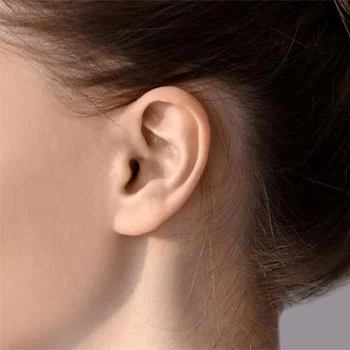What is a Prosthetic Ear?
A prosthetic ear, also known as an ear prosthesis, ear implant, or artificial ear, is a custom-made prosthetic device designed to replace all or part of an absent, damaged, or malformed external ear. It is typically created to restore the appearance of a missing or disfigured ear and improve the overall aesthetics of the face.
Ear prostheses are individually crafted to match the size, shape, and color of the natural ear or the contralateral ear (if present). They are typically made from medical-grade silicone or other suitable materials that resemble the texture and color of human skin. The prosthetic ear is carefully sculpted to replicate the intricate details and contours of a natural ear, including the helix, antihelix, lobule, and tragus.
The process of creating an ear prosthesis involves taking detailed measurements and impressions of the individual's ear or the contralateral ear. Skilled prosthetists or ear surgeons work closely with the individual to ensure the prosthesis is personalized and provides a natural and symmetrical appearance.
Ear prostheses can be held in place using various methods, such as adhesive bonding, magnetic attachment, or surgical implantation. The chosen method depends on factors such as the individual's preferences, the extent of the ear loss or deformity, and the recommendations of the healthcare professional.
Ear prostheses not only restore the aesthetic appearance of the ear but can also play a role in improving self-confidence, social interactions, and overall psychological well-being for individuals who have experienced ear loss or deformity due to congenital conditions, trauma, cancer, or other medical reasons.
Benefits of Prosthetic Ears?
A prosthetic ear serves several purposes for individuals who have experienced ear loss or deformity. Here are some key reasons why prosthetic ears are used:
- Restoring Appearance: The primary purpose of a prosthetic ear is to restore the natural appearance of the external ear. It helps to recreate the missing or disfigured ear, providing a symmetrical and aesthetically pleasing appearance to the face.
- Enhancing Self-Confidence: Ear loss or deformity can have a significant impact on an individual's self-esteem and body image. A prosthetic ear can help improve self-confidence by providing a sense of normalcy and completeness to one's appearance.
- Facilitating Social Interactions: The external ear plays an essential role in facial expressions and communication. By restoring the appearance of the ear, a prosthetic ear can help individuals feel more comfortable and confident in social situations, improving their interactions with others.
- Psychological Well-Being: The absence or deformity of an ear can cause emotional distress and psychological challenges. A prosthetic ear can contribute to an individual's overall psychological well-being, promoting a positive body image and reducing any negative impact on mental health.
- Protection and Support: In some cases, a prosthetic ear may also provide functional benefits. It can help protect the sensitive structures of the inner ear, such as the ear canal and eardrum, from environmental factors like dust, debris, or direct impact. Additionally, it can provide support for eyeglasses or hearing aids, improving their stability and comfort.
It is important to note that each individual's situation and reasons for using a prosthetic ear may differ. The decision to use a prosthetic ear is personal and depends on factors such as the extent of ear loss or deformity, individual preferences, and the recommendations of healthcare professionals involved in the treatment and rehabilitation process.
Who is an Ear Prosthesis Suitable For?
Ear prostheses are suitable for individuals who have experienced ear loss or deformity due to various reasons. Here are some situations where ear prostheses may be considered:
- Congenital Conditions: Individuals born with congenital ear anomalies, such as microtia (underdeveloped ear) or anotia (absence of the external ear), may benefit from ear prostheses. Prosthetic ears can help restore the appearance of a missing or underdeveloped ear, improving facial symmetry and aesthetics.
- Trauma or Injury: Accidents, burns, or traumatic events can result in partial or complete loss of the external ear. Ear prostheses can be used to replace the missing portion, providing a natural-looking ear and improving the individual's appearance.
- Cancer or Tumor Removal: Surgical removal of tumors, such as basal cell carcinoma or squamous cell carcinoma, may involve the removal of a portion or the entire external ear. Prosthetic ears can be utilized to reconstruct the ear and restore a normal appearance.
- Reconstruction after Surgery: In some cases, individuals may undergo surgical procedures, such as otoplasty or ear reconstruction surgery, to correct deformities or reshape the ear. Ear prostheses can be used as a temporary or permanent solution during the healing process or if the surgical outcome is not satisfactory.
- Failed Reconstructive Surgeries: Individuals who have previously undergone reconstructive surgeries that were not successful in achieving the desired results may consider ear prostheses as an alternative method of restoring the appearance of the ear.
It is important to note that the suitability of ear prostheses is determined on a case-by-case basis. Factors such as the extent of ear loss, individual preferences, overall health, and the recommendations of healthcare professionals specializing in ear prosthetics play a role in determining the appropriateness of prosthetic options.
Consulting with an ear surgeon, prosthetist, or healthcare professional experienced in ear prosthetics is crucial to assess an individual's specific situation and determine the most suitable approach for ear restoration.
How to Prepare For an Ear Prosthesis Procedure?
Preparing for an ear prosthesis procedure involves several steps to ensure a smooth and successful process. Here are some general guidelines to help you prepare:
- Consultation: Schedule an initial consultation with a qualified ear surgeon or prosthetist who specializes in ear prosthetics. During this consultation, discuss your specific situation, goals, and expectations. The professional will assess your condition and provide recommendations tailored to your needs.
- Medical Evaluation: Before the procedure, your healthcare provider may conduct a medical evaluation to ensure you are in good health and a suitable candidate for the prosthesis. This may involve reviewing your medical history, conducting physical examinations, and potentially ordering additional tests or imaging studies if necessary.
- Discuss Prosthetic Options: Your healthcare provider will discuss the various prosthetic options available, including materials, attachment methods, and customization. They will take measurements and impressions of your existing ear or the contralateral ear to ensure a precise and personalized fit.
- Communication and Expectations: Clearly communicate your expectations and desired outcomes to your healthcare provider. Discuss any concerns or questions you may have about the procedure, the prosthesis itself, or the recovery process. This allows for a better understanding and alignment of expectations between you and the healthcare provider.
- Follow Pre-Procedure Instructions: Follow any specific instructions provided by your healthcare provider. This may include avoiding certain medications or supplements that could interfere with the procedure, fasting if necessary, or discontinuing the use of any topical products on or around the ear before the procedure.
- Emotional Preparation: Preparing for an ear prosthesis procedure also involves emotional readiness. Understand that the process may involve multiple appointments, adjustments, and adaptations. It can be helpful to seek support from loved ones or join support groups to connect with others who have undergone similar procedures.
- Arrange Transportation and Support: Depending on the type of procedure, you may need someone to accompany you to and from the appointments. It's important to have transportation arrangements in place, especially if sedation or anesthesia is involved.
It's crucial to follow the specific instructions and guidance provided by your healthcare provider for the best possible outcome. They will provide you with personalized instructions based on your unique situation and needs.
Prosthetic Ear Procedure
The procedure for obtaining an ear prosthesis typically involves several stages, including impression-taking, prosthesis fabrication, fitting, and adjustments. Here is a general overview of the stages involved in an ear prosthesis procedure:
- Consultation and Evaluation: During the initial consultation, you will discuss your goals, expectations, and the specific details of your ear prosthesis with a qualified ear surgeon or prosthetist. They will evaluate your individual situation, assess the extent of ear loss or deformity, and determine the most appropriate course of action.
- Impression-Taking: To create a custom-fit ear prosthesis, impressions of your existing ear or the contralateral ear (if available) will be taken. This involves using a moldable material or a digital scanner to capture the precise dimensions and contours of the ear. These impressions will serve as a basis for creating a prosthetic ear that closely matches your natural ear.
- Prosthesis Fabrication: Based on the impressions, a skilled prosthetist will craft the ear prosthesis using medical-grade silicone or other suitable materials. They will carefully sculpt and color the prosthesis to recreate the intricate details and textures of a natural ear. The process involves multiple steps, including molding, sculpting, and coloring, to achieve a realistic appearance.
- Fitting and Adjustments: Once the prosthesis is fabricated, you will have a fitting appointment. The prosthetist will ensure that the prosthesis fits comfortably and securely. They will make any necessary adjustments to achieve the desired fit and appearance. This may involve trimming, reshaping, or refining the prosthesis to ensure optimal aesthetics and functionality.
- Attachment Method: Depending on the chosen attachment method, the prosthetist will secure the prosthesis to your existing ear or the surrounding tissues. This can be done using adhesive bonding, magnetic attachment, or surgical implantation. The chosen method will depend on factors such as your preferences, the extent of ear loss or deformity, and the recommendations of the healthcare professional.
- Education and Care Instructions: The prosthetist will provide you with comprehensive instructions on how to care for and maintain your ear prosthesis. This may include guidelines for cleaning, removal, and reattachment of the prosthesis. They will also educate you on any specific considerations or precautions to ensure the longevity and proper functioning of the prosthesis.
- Follow-up Appointments: After the initial fitting, follow-up appointments may be scheduled to monitor the fit, make any necessary adjustments, and address any concerns or issues that may arise. These appointments help ensure ongoing comfort and satisfaction with the prosthesis.
It's important to note that the specific details of the ear prosthesis procedure can vary depending on individual circumstances, the chosen prosthetic method, and the expertise of the healthcare professionals involved. Consulting with a qualified ear surgeon, prosthetist, or healthcare professional specializing in ear prosthetics will provide you with personalized guidance and a more detailed understanding of the stages involved in your particular case.
Recovery and Aftercare
After receiving an ear prosthesis, proper recovery and aftercare are essential to ensure the best outcome and longevity of the prosthesis. Here are some key points to consider:
- Follow Post-Procedure Instructions: Your healthcare provider will provide specific instructions on how to care for the prosthesis and the surrounding area. Follow these instructions carefully to minimize the risk of complications and promote optimal healing.
- Cleaning and Maintenance: Regularly clean the prosthesis as instructed by your healthcare provider. This typically involves using mild soap and water or specialized cleaning solutions. Avoid using harsh chemicals or abrasive materials that could damage the prosthesis. Proper cleaning helps maintain the appearance, hygiene, and durability of the prosthesis.
- Skin Care: Pay attention to the skin around the prosthesis. Keep the area clean and dry to prevent irritation or infection. If any redness, swelling, or discomfort occurs, contact your healthcare provider promptly.
- Adhesive Use (if applicable): If your prosthesis is attached using adhesive bonding, follow the recommended guidelines for applying and removing the adhesive. Be mindful of any allergic reactions or skin sensitivities that may arise from the adhesive. Consult your healthcare provider if you experience any adverse reactions.
- Regular Check-ups: Schedule regular follow-up appointments with your healthcare provider to monitor the fit, function, and condition of the prosthesis. They can make any necessary adjustments or address any concerns that may arise during these visits.
- Protecting the Prosthesis: Take precautions to protect the prosthesis from accidental damage. Avoid subjecting it to excessive force, heat, or direct sunlight. If engaging in activities that pose a risk of damage, such as contact sports, consider using protective gear or temporarily removing the prosthesis as advised by your healthcare provider.
- Emotional Support: Adjusting to an ear prosthesis may involve emotional and psychological adjustments. Seek support from loved ones or consider joining support groups where you can connect with others who have undergone similar procedures. Counseling or therapy may also be beneficial if needed.
- Long-term Care: Over time, the prosthesis may require periodic adjustments or replacement due to changes in the shape of the face or natural wear and tear. Regularly communicate with your healthcare provider to assess the ongoing fit and function of the prosthesis.
Remember to consult with your healthcare provider regarding any specific aftercare instructions and recommendations based on your unique situation. They will provide personalized guidance to ensure a successful recovery and long-term satisfaction with your ear prosthesis.
Ear Prosthesis Risks and Complications
While ear prosthesis procedures are generally safe, there are potential risks and complications that individuals should be aware of. These can include:
- Allergic Reactions: Some individuals may develop an allergic reaction to the materials used in the prosthesis, such as medical-grade silicone or adhesive. This can result in skin irritation, redness, itching, or swelling. It is important to notify your healthcare provider if you experience any allergic symptoms.
- Infection: There is a risk of infection at the site of attachment or around the prosthesis. Proper hygiene and following the recommended cleaning instructions can help minimize this risk. If you notice signs of infection, such as increased redness, swelling, pain, or discharge, seek medical attention promptly.
- Skin Irritation: Prolonged or improper use of adhesive bonding methods can lead to skin irritation or breakdown. It is important to follow the recommended guidelines for adhesive use, including proper removal techniques, to minimize the risk of skin problems.
- Discomfort or Pressure Points: In some cases, the prosthesis may cause discomfort or pressure points due to improper fit or adjustments. This can lead to pain, skin breakdown, or difficulty wearing the prosthesis. Regular follow-up appointments with your healthcare provider can help address and resolve any discomfort or fit-related issues.
- Changes in Facial Structure: Over time, changes in the shape or contour of the face may occur, which can affect the fit and appearance of the prosthesis. This may require periodic adjustments or a replacement prosthesis to maintain an optimal fit and aesthetics.
- Psychological and Emotional Impact: Adjusting to an ear prosthesis can have psychological and emotional implications. Some individuals may experience body image concerns, self-esteem issues, or emotional distress related to the prosthetic ear. Seeking support from loved ones, support groups, or mental health professionals can be beneficial in managing these concerns.
It is important to discuss the potential risks and complications with your healthcare provider before undergoing an ear prosthesis procedure. They will provide you with detailed information about the specific risks relevant to your case and address any concerns you may have. Adhering to proper aftercare instructions and maintaining regular follow-up appointments can help minimize the occurrence of complications and ensure a successful outcome.
Prosthetic Ear Cost
The cost of a prosthetic ear can vary depending on several factors, including the complexity of the case, the materials used, the expertise of the healthcare professional, and the geographical location. It is important to note that the following information provides a general idea of the cost range and that specific pricing details should be obtained from healthcare providers or prosthetists.
The cost of a non-surgical prosthetic ear typically ranges from several hundred dollars to several thousand dollars. Factors influencing the cost include:
- Prosthesis Material: The choice of material for the prosthesis can affect the cost. Medical-grade silicone is commonly used due to its durability and realistic appearance, but it can be more expensive than other materials.
- Customization Requirements: The level of customization needed for the prosthesis, including sculpting, coloring, and texture matching, can influence the cost. Highly detailed and realistic prostheses may require more time and expertise to create, resulting in higher costs.
- Attachment Method: The specific attachment method used for the prosthesis can impact the overall cost. Adhesive bonding methods may require ongoing adhesive purchases, while magnetic attachment or implant-supported prostheses may involve additional surgical procedures, which can increase the overall cost.
- Healthcare Professional Fees: The fees charged by the healthcare professional, such as the ear surgeon or prosthetist, can vary. Factors such as their expertise, experience, and geographical location can influence the cost of their services.
- Insurance Coverage: It is important to check with your health insurance provider to determine if they cover the cost of a prosthetic ear. Some insurance plans may provide partial or full coverage, depending on the circumstances and the individual's policy.
It is recommended to consult with healthcare professionals or prosthetists specializing in ear prosthetics to obtain accurate and up-to-date pricing information based on your specific needs and circumstances. They can provide you with a detailed breakdown of the costs involved and discuss any potential financing options that may be available.
Frequently Asked Questions
How long does a prosthetic ear last?
The lifespan of a prosthetic ear can vary depending on several factors, including the materials used, the quality of craftsmanship, individual wear and tear, and changes in the shape of the face. That said, the durability of an ear prosthesis typically ranges from 2 to 5 years.
Should I take off my prosthetic ear before sleep?
Most specialists generally recommend removing the prosthetic ear before going to bed. This allows your skin to have a break from prolonged wear, reducing the risk of discomfort, pressure sores, or skin irritation. This also allows for thorough cleaning of both the prosthesis and the skin around it, which helps to maintain good hygiene, prevents the buildup of sweat, dirt, or oils, and reduces the risk of skin problems or infections.
Should I take off my prosthetic ear before exercise?
Whether or not to remove your prosthetic ear during exercise depends on personal preference, the type of exercise, and guidance from your healthcare provider. Factors to consider include comfort, sweat and moisture, impact and intensity of exercise, and the attachment method. Most specialists recommend removing the prosthetic ear for comfort, hygiene, and protection during exercise, especially for intense physical activity or when the prosthesis is not designed to withstand sweat or moisture.
What should I do to prevent my prosthetic ear from falling off?
To prevent your prosthetic ear from falling off, follow these tips: ensure proper attachment, clean and dry the skin before attaching, maintain adhesive if applicable, avoid excessive moisture, use protective measures during high-risk activities, and schedule regular check-ups with your healthcare provider.




